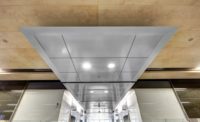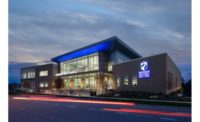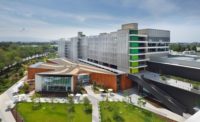One of Germany’s first coffee houses opened in Schillerplatz, a beautiful square in Stuttgart’s old city center, in 1712. Nestled between the Old Castle and Stiftskirche, it served as a central gathering place for locals and travelers making their way through the southern German city. Replaced in 1798 by the König von England (King of England) Inn, it remained an important meeting place until its destruction during World War II. Stuttgart was damaged significantly during the war, with over 140,000 bombs dropped by allied troops.
Eventually, the former site of the coffee house and inn was developed into an administrative building. Listed since 1984, it was recently refurbished and modernized by the Baden-Württemberg state ministries. The primary objective of the refurbishment was to retain the positive aspects of the building’s character while providing users with state-of-the-art facilities. To ensure optimal room acoustics and a contemporary, attractive aesthetic for the top floor (which was converted into a conference center), the architects opted for a gold-anodized acoustic ceiling made of aluminum mesh. Manufactured by GKD, the ceilings are spectacular and for the most part, one-of-a-kind additions to the space.
Modernization Meets Conservation
The refurbishment of the historical building posed a variety of challenges to Stuttgart-based architect firm zsp Architekten. The plan involved the refurbishment of all structural and energy-related aspects of the façade and roof surfaces, as well as the entire interior. Since the facility’s ground floor is home to several shops, uninterrupted sales operations throughout the entire refurbishment further complicated the project.
Both the reinforced concrete skeleton, with its travertine façade and the historical steel composite windows of the building needed to be retained. Using restorative coating analyses and photographs of the building taken during construction, some walls and windows were restored to their original colors. Fire protection was optimized along with the removal of harmful materials. Throughout the interior of the building, surfaces and technical facilities were given a modern facelift.
Finding the Right Fit
The top floor of the building received extra attention during the design and build process. Originally converted into apartments, the new owners wanted it to be converted into a conference and meeting room. However, the ceiling structure presented particular challenges to the architects when it came to equipping the narrow, but very long room with a lobby. They required a large, grid-free ceiling that combined acoustic properties and a formal appearance. The team found the perfect solution in the CMP mesh ceiling system by GKD.
An aluminum honeycomb supporting plate allows large, rigid panels to be used and the gold-anodized surface layer made of Alu 6010 aluminum mesh gives the room a royal feel that befits the history of the location. Furthermore, the room acoustics are optimized using an intermediate layer of acoustic fleece. Large panels were fitted to an area totaling around 100 square meters. Finishing and fastening of the large panels were simplified by the highly stable and lightweight nature of the overall structure. The honeycomb supporting plate is mounted to the substructure by means of a perforated plate with L-shaped brackets fitted to the back.
As such, the top floor of the new King of England now boasts a glossy ceiling surface with a monolithic effect. The reduced number of joints resulting from the large dimensions of the panels and their butt joint design underlines this effect and the round LED ceiling lights further enhance the shine of the metallic mesh. The GKD ceiling system sets the tone when it comes to visuals and acoustics in the conference room, even during the most heated discussions.
A New King of Ceiling Systems
GKD’s new CMP mesh ceiling system resulted from conversations with architects and designers who wanted a beautiful, functional and easy to install metal mesh option. Available in rigid or flexible panels, rigid meshes are generally used for flat ceilings, whereas the flexible meshes (usually rigid one direction and flexible in the other) can be contoured or curved. These meshes can be cut into a variety of shapes, then bored and trimmed to accommodate lighting, sprinkler systems and other fixtures.
The ceiling system is installed with GKD’s accessible clip system. Ceiling panels are sized and formed into a “pan” shape providing panel stability and a finished appearance. The ceiling can be acoustically passive or active, depending on the addition of an acoustic blanket. The grid support network is above the ceiling panels and is secured by clips from the grid system. Such a system is readily demounted for access to ductwork, plumbing or wiring, and spacing between rows of panels varies, providing space for sprinklers or lighting while allowing for airflow. It’s a new king among ceiling systems.







Report Abusive Comment